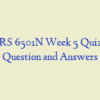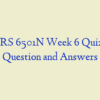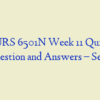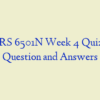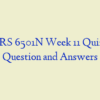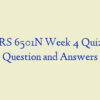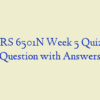Description
NURS 6501N WEEK 5 QUIZ 1 – Question and Answers
- A 72-year-old female has a history of right heart failure caused by a right ventricular myocardial infarction. Which of the following symptoms are specifically related to her right heart failure?
- Which is the most common type of congenital heart defect the nurse should assess for in infants?
- A nurse is teaching a patient about anaphylactic shock. Which information should the nurse include? The onset of anaphylactic shock is usually:
- A 30-year-old female presents to her primary care provider with fever, cardiac murmur, and petechial skin lesions. She is diagnosed with infective endocarditis. When the patient wants to know what caused the disease, what is the nurse’s best response? The most likely cause of the disease is:
- While planning care, the nurse remembers which principle? In valvular _____, the valve opening is constricted and narrowed because the valve leaflets, or cusps, fail to open completely.
- A 55-year-old male died of a myocardial infarction. Autopsy would most likely reveal:
- A 50-year-old male was admitted to the intensive care unit with a diagnosis of acute myocardial infarction (MI). He is being treated for shock. His cardiopulmonary symptoms include low blood pressure, tachycardia, and tachypnea. His skin is pale and cool. The primary cause of his shock is most likely:
- A newborn experiences frequent periods of cyanosis, usually occurring during crying or after feeding. Which of the following is the most likely diagnosis the nurse will observe on the chart?
- A 10-year-old male presents with fever, lymphadenopathy, arthralgia, and nose bleeds. He is diagnosed with rheumatic heart disease. While planning care, which characteristic changes should the nurse remember?
- A 15-year-old male who is allergic to peanuts eats a peanut butter cup.
- He then goes into anaphylactic shock. Which assessment findings will the nurse assess for?
- A newborn child has a murmur and cyanosis. An echocardiogram reveals that the tricuspid valve failed to develop and no blood flows between the right atrium and ventricle. What term will the nurse use to describe this condition? Tricuspid:
- A 27-year-old male is admitted to a neurologic unit with a complete C-5 spinal cord transection. On initial assessment, he is bradycardic, hypotensive, and hyperventilating. He appears to be going into shock. The most likely mechanism of his shock is:
- A 75-year-old male has severe chest pain and dials 911. Lab tests at the hospital reveal elevated levels of cardiac troponins I and T. Based upon the lab findings, the nurse suspects which of the following has occurred?
- A 42-year-old female is diagnosed with constrictive pericarditis. The nurse assesses the blood pressure for decreased cardiac output because of:
- For an infection to progress to septic shock, which of the following factors should the nurse determine occurred?
- A nurse is planning care for a patient in shock. Which principle should the nurse remember? During shock states, glucose uptake is usually:
- A 3-year-old male is diagnosed with Kawasaki disease. Which of the following does the nurse suspect is the most likely cause?
- A 60-year-old female had a myocardial infarction. She was brought to the hospital 30 minutes later. She survived, but now the nurse is providing care for impaired ventricular function because:
- Which of the following lab tests will the nurse check to help diagnose heart failure and provide insight into its severity?
- A 22-year-old pregnant female presents for a fetal echocardiogram. Tests reveal small left atrium and mitral valve and an absent left ventricle and aortic valve. The diagnosis is hypoplastic left heart syndrome (HLHS). The nurse will anticipate that the treatment for this defect is:
- A 49-year-old male presents to his primary care provider reporting chest pain. EKG reveals ST elevation. He is diagnosed with myocardial ischemia. Which of the following interventions would be most beneficial?
- An infant undergoes an echocardiogram for a suspected heart defect. Tests reveal an opening in the middle of the atrial septum. What term would the nurse use to describe this defect?
- A newborn baby is severely cyanotic. An echocardiogram reveals transposition of the great arteries. A nurse assesses for which of the following, as it usually occurs with this defect?
- A nurse is teaching staff about endocarditis. Which information should the nurse include? Inflammatory cells have difficulty limiting the colonization of microorganisms in infective endocarditis because the:
- A newborn is diagnosed with congenital heart disease. Which of the following intrauterine factors should the nurse focus on during the history that could have caused this disorder?
- One consequence of switching from aerobic to anaerobic cellular metabolism during shock states is:
- A 2-week-old infant presents with poor feeding, fatigue, dyspnea, and a murmur. She is diagnosed with a patent ductus arteriosus (PDA). A nurse recalls this condition results in a(n):
- A newborn child is diagnosed with tetralogy of Fallot.
- What symptoms would the nurse expect to observe in the child?
- A 20-year-old male underwent an echocardiogram to assess chest pain. Results revealed a congenital defect in papillary muscles. Which of the following would the nurse expect to occur?
- A 75-year-old obese female presents to her primary care provider reporting edema in the lower extremities. Physical exam reveals that she has varicose veins. Upon performing the history, which of the following is a possible cause for the varicose veins?
NURS 6501N Week 5 Quiz 2
- An 80-year-old female is in the hospital for a bone fracture. While there she develops a large, nonlethal pulmonary embolus. Which of the following is a direct result of the obstruction to pulmonary blood flow?
- A 54-year-old male is diagnosed with left bundle branch block. Which of the following structures would not receive an electrical impulse?
- A 52-year-old female is diagnosed with coronary artery disease. The nurse assesses for myocardial:
- A 50-year-old male is diagnosed with orthostatic hypotension. Which of the following symptoms would he most likely experience?
- A 65-year-old male is diagnosed with chronic pulmonary disease and elevated pulmonary vascular resistance. Which of the following heart failures should the nurse assess for in this patient?
- When a patient has a massive pulmonary embolism (PE), what complications will the nurse monitor for?
- A 62-year-old male presents to his primary care provider reporting chest pain at rest and with exertion. He does not have a history of coronary artery disease and reports that the pain often occurs at night. He is most likely experiencing which type of angina?
- A patient wants to know what causes atherosclerosis. How should the nurse respond? In general, atherosclerosis is caused by:
- While planning care for a patient with superior vena cava syndrome (SVCS), which principle should the nurse remember? SVCS is a progressive _____ of the superior vena cava (SVC) that leads to venous distention of the upper extremities and head.
- A 50-year-old male visits the cardiologist for an EKG. Results indicate that he has no PR interval and a variable QRS rate with rhythm irregularity.
- Which of the following is the most likely diagnosis to be recorded on the chart?
- Most cases of combined systolic and diastolic hypertension have no known cause and are documented on the chart as _____ hypertension.
- A 75-year-old female has been critically ill with multiple organ dysfunction syndrome (MODS) for longer than a week and has developed a severe oxygen supply and demand imbalance. The statement that best describes this imbalance is which of the following?
- A 28-year-old female presents with severe chest pain and shortness of breath. She is diagnosed with pulmonary embolism, which most likely originated from the:
- A 50-year-old female received trauma to the chest that caused severe impairment of the primary pacemaker cells of the heart. Which of the following areas received the greatest damage?
- An 82-year-old female was admitted to the hospital with confusion and severe hypotension. Her body’s compensatory mechanisms are increased heart rate, vasoconstriction, and movement of large volumes of interstitial fluid to the vascular compartment. What kind of shock does the nurse suspect the patient is experiencing?
- Many valvular stenosis and regurgitation disorders in adults have a common etiology. Which of the following conditions should alert the nurse that the patient may have both types of valve dysfunction?
- When a nurse checks the patient for orthostatic hypotension, what did the nurse have the patient do?
- A 60-year-old male undergoes surgery for a bone fracture. Which of the following nursing measures would be most effective for preventing pulmonary embolism (PE) in this patient?
- A 65-year-old male is transported to the ER for chest pain. An electrocardiogram reveals a prolonged QRS interval. What is the nurse monitoring when the nurse observes the QRS complex on the electrocardiogram? The QRS complex reflects:
- A 60-year-old male presents to his primary care provider reporting chest pain. He is diagnosed with atherosclerosis. This disease is caused by:
- A 56-year-old male is diagnosed with coronary artery disease. Which of the following modifiable risk factors would the nurse suggest the patient change?
- A nurse monitors the patient for _____ when rapid onset of malignant hypertension results.
- Which organ should the nurse monitor closely since it is often the first to fail in patients with multiple organ dysfunction syndrome (MODS)?
- A 5-year-old female is found to have hypertension during three separate visits to her primary care provider. The nurse would expect tests to suggest that the hypertension is secondary to:
- A 30-year-old Caucasian female was recently diagnosed with primary hypertension. She reports that she eats fairly well, usually having red meat and potatoes daily. She also reports that her father has hypertension as well. A nurse determines which of the following risk factors is most likely associated with this diagnosis?
- A 50-year-old male with a 30-year history of smoking was diagnosed with bronchogenic cancer.
- He developed edema and venous distention in the upper extremities and face. Which of the following diagnosis will the nurse observe on the chart?
- A 50-year-old female presents with a low heart rate and low blood pressure. She is given an intravenous (IV) infusion of fluids. The increase in atrial distension results in:
- A 70-year-old female is in the hospital for pelvic fracture. She develops pulmonary thromboembolism. The nurse realizes this embolus is composed of:
- A 52-year-old male is diagnosed with primary hypertension. He has no other health problems. Present treatment would cause the nurse to anticipate administering which drug to the patient?
- A 32-year-old female presents with lower leg pain, with swelling and redness. While obtaining the patient’s history, which finding could have caused her condition?
NURS 6501N Week 5 Quiz 3
- A newborn baby is severely cyanotic. An echocardiogram reveals transposition of the great arteries. A nurse assesses for which of the following, as it usually occurs with this defect?
- A nurse is teaching staff about endocarditis. Which information should the nurse include? Inflammatory cells have difficulty limiting the colonization of microorganisms in infective endocarditis because the:
- Upon assessment of the patient, the nurse finds a widened pulse pressure and throbbing peripheral pulses. Which valve disorder does the nurse suspect?
- A newborn experiences frequent periods of cyanosis, usually occurring during crying or after feeding. Which of the following is the most likely diagnosis the nurse will observe on the chart?
- An infant undergoes an echocardiogram for a suspected heart defect. Tests reveal an opening in the middle of the atrial septum. What term would the nurse use to describe this defect?
- A newborn child is diagnosed with tetralogy of Fallot. What symptoms would the nurse expect to observe in the child?
- A 72-year-old female has a history of right heart failure caused by a right ventricular myocardial infarction. Which of the following symptoms are specifically related to her right heart failure?
- A 51-year-old male presents with recurrent chest pain on exertion. He is diagnosed with angina pectoris. When he asks what causes the pain, how should the nurse respond? The pain occurs when:
- A 1-month-old infant was diagnosed with truncus arteriosus (TA) with a ventricular septal defect. Which of the following would the nurse also expect?
- Which of the following lab tests will the nurse check to help diagnose heart failure and provide insight into its severity?
- A nurse is teaching a patient about anaphylactic shock. Which information should the nurse include? The onset of anaphylactic shock is usually:
- A 1-month-old infant visits his primary care provider for a well-baby check. Physical exam reveals decreased cardiac output, hypotension, tachycardia, and a loud murmur suggestive of aortic stenosis. Which of the following would be expected with this diagnosis?
- A 49-year-old male presents to his primary care provider reporting chest pain. EKG reveals ST elevation. He is diagnosed with myocardial ischemia. Which of the following interventions would be most beneficial?
- A newborn is diagnosed with congenital heart disease. Which of the following intrauterine factors should the nurse focus on during the history that could have caused this disorder?
- A newborn child has a murmur and cyanosis. An echocardiogram reveals that the tricuspid valve failed to develop and no blood flows between the right atrium and ventricle. What term will the nurse use to describe this condition? Tricuspid:
- When a patient asks the nurse what is the most common cause of myocardial ischemia, which statement is the correct response? The most common cause of myocardial ischemia is:
- A nurse recalls the most common cardiac valve disease in the United States, which tends to be most prevalent in young women, is:
- A 2-week-old infant presents with poor feeding, fatigue, dyspnea, and a murmur. She is diagnosed with a patent ductus arteriosus (PDA). A nurse recalls this condition results in a(n):
- A 75-year-old obese female presents to her primary care provider reporting edema in the lower extremities. Physical exam reveals that she has varicose veins. Upon performing the history.
- Which of the following is a possible cause for the varicose veins?
- A nurse is planning care for a patient in shock. Which principle should the nurse remember? During shock states, glucose uptake is usually:
- A 22-year-old pregnant female presents for a fetal echocardiogram. Tests reveal small left atrium and mitral valve and an absent left ventricle and aortic valve. The diagnosis is hypoplastic left heart syndrome (HLHS). The nurse will anticipate that the treatment for this defect is:
- A 10-year-old male presents with fever, lymphadenopathy, arthralgia, and nose bleeds. He is diagnosed with rheumatic heart disease. While planning care, which characteristic changes should the nurse remember?
- A 56-year-old male presents to his primary care provider for a checkup. Physical exam reveals edema, hepatomegaly, and muffled heart sounds. Which of the following is of greatest concern to the nurse?
- A 60-year-old female was diagnosed with mitral stenosis. As a result, the nurse realizes the patient has incomplete emptying of the:
- A 42-year-old female is diagnosed with constrictive pericarditis. The nurse assesses the blood pressure for decreased cardiac output because of:
- An 8-week-old infant presents to her primary care provider for a well-baby check. Physical exam reveals a murmur, and an echocardiogram shows a large ventricular septal defect. If left untreated, what condition should the nurse discuss with the parents?
- While planning care, the nurse remembers which principle? In valvular _____, the valve opening is constricted and narrowed because the valve leaflets, or cusps, fail to open completely.
- A 50-year-old male was admitted to the intensive care unit with a diagnosis of acute myocardial infarction (MI).
- He is being treated for shock. His cardiopulmonary symptoms include low blood pressure, tachycardia, and tachypnea. His skin is pale and cool. The primary cause of his shock is most likely:
- A 60-year-old female had a myocardial infarction. She was brought to the hospital 30 minutes later. She survived, but now the nurse is providing care for impaired ventricular function because:
- For an infection to progress to septic shock, which of the following factors should the nurse determine occurred?
- So, check out our latest Tutorials and Courses on BUSI 413.
![]()


